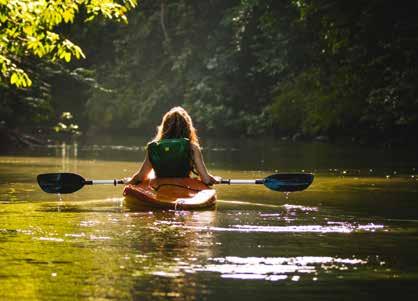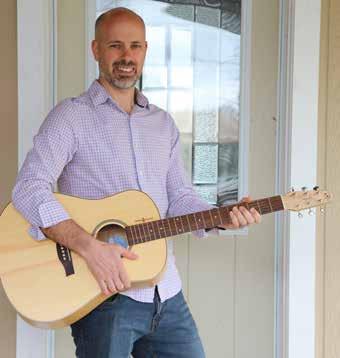
5 minute read
SAVING THE
Province, Trent-Severn Waterway not off the hook as group works to save the walleye
GEOFF COLEMAN, WRITER-AT-LARGE
Advertisement
Foot-dragging by the provincial government and inconsistent water flow resulting from Trent-Severn Waterway management practices are frustrating the efforts of a local organization to enhance walleye spawning habitat to protect this important fish from further decline.
At issue is the area immediately downstream of the TSW’s Bobcaygeon dam. Once a significant spring spawning area from bank to bank, it now only supports spawning on the north side, and poorly at that. Correcting the situation has been a five-year mission for Save the Walleye, a group spearheaded by Larry Jones and Doug Coombs.
Jones, a long-time resident, fisherman and taxidermist says when the Pigeon Lake walleye population was at its peak, there was never a question of whether you would catch your limit of fish. The only question was how long it would take. And this predates common technical aids such as fish finders and accurate lake maps housed on cellphones. At spawning time, the smell of walleye hung in the air. The beds were covered with fish from bank to bank every night.
However, things started to drop off by the mid-1970s, and by the late 1980s the fishing was a shadow of what it once was. Gone were the opening nights when as Jones puts it, “you could walk from boat to boat across the river,” and the resulting American tourist dollar influx had all but dried up.
There are as many opinions on what caused the decline as there are anglers, but members of Save the Walleye believe it has been a result of water management practices by the waterway. In 1968, a newly installed dam at Bobcaygeon released water from a bottommounted gate at such a velocity that the fist-sized stone on southern side of the spawning area was washed away by the flow. Previously, stop logs controlled the outflow, moving out warmer surface water at a slower pace.
The gates also created a reduced and erratic flow on the northern side. Eggs laid there one night could be high and dry the next, or washed away in suddenly powerful current. In 2015, Save the Walleye started a campaign to get the water flow problem corrected. Save the Walleye would like to see a study that investigates using the raceways of the dam that still have stop logsto direct water over the north side of the spawning bed. “We are just talking about removing a few logs — maybe they’d have to do it a few times
Mark Byles on Cameron Lake. before they got it right — and sending the water where it needs to go. It’s easy and cheap,” Coombs explains.
For its part, the Ontario Ministry of Natural Resources and Forestry says it is ready to support Save the Walleye.
Minister John Yakabuski’s office stated, the Minister “has met with the Save the Walleye group, along with his colleague local MPP and Minister of Infrastructure Laurie Scott, to discuss their concerns and share his support of their proposed actions to strengthen walleye populations.” He has also discussed the matter with MP Jamie Schmale and written to federal Fisheries Minister Jonathan Wilkinson to engage the federal government on this file.
“Our government is committed to working together to provide advice as required to support the project. We will continue to communicate with Parks Canada’s water management team to help inform their decisions about water level management and how to best protect fisheries resources during critical periods, including the walleye spawning season.” (Parks Canada is the agency responsible for the Trent-Severn Waterway.)
Coombs says he has heard that response before, and it doesn’t necessarily mean that the ministry agrees that adjusting water flow actually is the way to “best protect fisheries resources.” After five years of meetings and discussions to get what his group says is a simple project off the ground, Coombs has plenty of experience to back up that opinion. “What has the MNRF done to physically help the walleye in the Kawartha Lakes?” he asks. “You can’t regulate them back to health.”
A big part of the problem is that the Ontario government does not have jurisdiction regarding the expansion or rehabilitation of walleye spawning areas in Bobcaygeon, which fall under the mandate of the Trent-Severn and therefore Parks Canada. Fortunately, the TSW recently agreed to allow testing of the Save the Walleye proposal, provided an environmental Basic Impact Assessment was completed. Facing a $150,000 bill for that study, the group turned to Kawartha Conservation, which said it could complete the assessment as part of its mandate, pending post-COVID 19 budget changes.
When the environmental assessment is done, it will be up to the TSW to green-light the study. Although it’s too late to get things moving this year, with some intergovernmental cooperation, the problem of a declining walleye fishery could be water over the dam. For more information see savethewalleye.ca
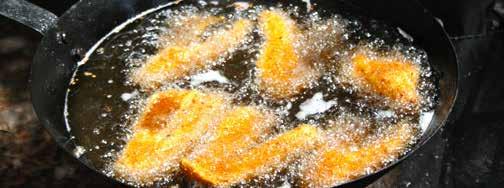
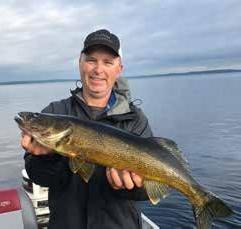
How are the walleye doing?
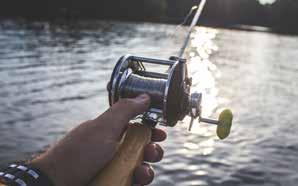
Studies done in 2009 and 2013 for the Ontario Ministry of Natural Resources and Forestry both show walleye accounting for four per cent of the total number of fish captured. Both the largest walleye and the average size increased over the four years. But does that mean the local population is healthy? Local anglers point out that the percentage of walleye hasn’t increased, indicating there’s been no improvement. Their stories bear that out. Bobcaygeon’s Richard Junkin has been fishing for 40 years, when it was common to catch 30 walleye in a day, and heard stories of his grandfather’s days as a guide on Pigeon Lake in the 1950s and 60s. These days, Junkin says, even if you get up early, it’s not easy to catch multiple walleye in one outing. Maybe that kind of over-fishing caused the decline in walleye stocks? Larry Jones of Save the Walleye notes that the white sucker population has also dropped, suggesting an environmental problem that affects both. —GC


